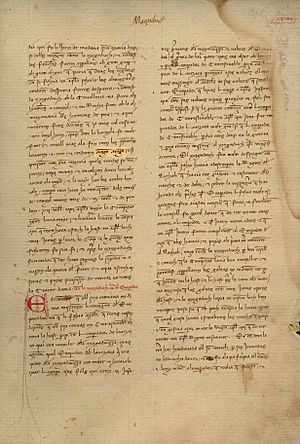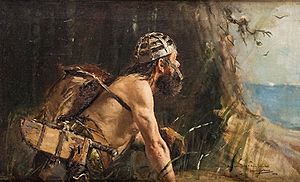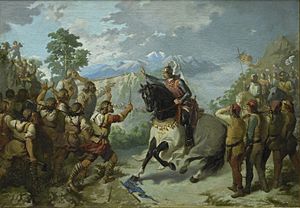Almogavars facts for kids

The Almogavars (Spanish: almogávares, Aragonese: almugávares, Catalan: almogàvers and Portuguese: almogávares) were a special kind of light infantry soldier. They came from the Crown of Aragon and were active during the 13th and 14th centuries, especially in the later parts of the Reconquista.
These soldiers were known for being lightly dressed, fast, and fighting on foot. They came from different parts of the Iberian Peninsula, including the Kingdom of Aragon, Principality of Catalonia, Kingdom of Valencia, Crown of Castile, and Kingdom of Portugal. Many of them were originally farmers and shepherds from wild, mountainous border areas. Over time, they also worked as mercenaries in places like Italy, Greece, and the Middle East.
Contents
What's in a Name?
The name "Almogavar" comes from an Arabic word, Arabic: المغوار (al-mughāwir), which means "Raiders." This name fits them well because they were known for their quick attacks. Even the names of their military ranks, like "Adalid" and "Almocaden," came from Arabic words.
How the Term Started
The word "Almogavar" was first used in the 10th century in Al-Andalus (Muslim Spain). It described small groups of Saracens (Muslims) who carried out surprise attacks and raids. The first written record of this term appeared in a chronicle by Ahmad ibn Muhammad al-Razi, a historian from that time.
Later, during the final centuries of the Reconquista, the term "Almogavar" was also used for Moorish (Muslim) bandits who launched attacks from the kingdom of Granada into Christian towns.
Christians Adopt the Style
The Aragonese were the first Christians to start fighting like these Saracen groups. Because they adopted these tactics, they eventually became known by the same name: Almogavars.
For example, in 1177, King Alfonso the Chaste helped the Castilian king besiege the city of Cuenca. He brought a group of foot soldiers who were identified as Almogavars.
Their Background
Life on the border between Christian and Muslim lands was tough. To survive, Christian shepherds often had to form groups and raid enemy territory for food and supplies. These raids usually lasted only a few days, and the Almogavars were skilled at living off the land and sleeping outdoors. Their experience as shepherds in wild mountains taught them how to survive with few resources.
Over generations, this way of life turned into a warrior spirit. It became easier to make a living through quick raids than by working hard all year. This lifestyle was adopted by people living near the Muslim borders as Christian kingdoms expanded south. Sometimes, even Islamic Almogavars fought alongside Catholic Almogavars.
What They Were Like
Almogavars were known as shock troops who fought on foot. They carried light weapons and gear, usually two javelins, a short spear (called "ascona muntera"), and a falchion (a type of sword). They wore simple, short gowns in all seasons, with a thick leather belt and leather sandals. They also had long beards.
Before battle, they would strike their weapons with a piece of flint, creating sparks. This, along with their loud battle cries, was meant to scare their enemies. They were very brave and fierce. Almogavars from the Crown of Aragon would often shout, "Awake iron! Let's kill, let's kill!", "for Saint George!", and "Aragon! Aragon!" as they charged into combat.

It's important to remember that their appearance and fighting style could change depending on the time and place. For example, later Almogavars who fought near the border of Granada in the 15th and 16th centuries were often town residents who knew the local area very well.
Their main traits were:
- Living for war, not just as a job but as a way of life.
- Being perfectly suited for fighting on the border with Muslim territories.
- Earning money from looting and selling or rescuing prisoners.
- Being tough, able to endure hardship, and not needing much.
- Using light weapons.
- Having a clear military structure.
Ranks and Requirements
King Alfonso X of Castile wrote down the requirements for Almogavars in his laws, called the Siete Partidas. These included being fit, strong, and agile. The laws also explained their different ranks.
Adalid (Leader)
The "Adalid" was the highest rank among the Almogavars. The word comes from an Arabic word meaning "guide." An Adalid needed to be wise, brave, smart, and loyal. They guided the army, avoided dangers, found safe places with water and food, and tracked the enemy. They also planned raids and made all decisions about them. An Adalid had a status similar to a knight.
To become an Adalid, other Adalids or officials would swear that the candidate was ready for the job. Then, the king or an official would give them a sword and a baldric (a belt worn over the shoulder). The new Adalid would stand on a shield, and the king would unsheathe the sword and place it in their hand. Other adalids would lift him up, and he would make a cross shape in the air with his sword, challenging the enemies of the faith. After this, the king would declare, "From henceforth you are an Adalid." Adalids usually rode horses.
Almocaden
The "Almocaden" came from the Arabic word for "captain." This was an experienced Almogavar who was chosen as a leader by his group. They also seemed to be mounted on horses sometimes.
Almogavar
These were the lowest rank, also called "countrymen" or "pawns" in Castile. They made up most of the army. To become an Adalid, you first had to be a mounted Almogavar, then an Almocaden, and before that, just an Almogavar.
Their Military Importance
Almogavars were considered one of the best infantry forces of their time. While cavalry (soldiers on horseback) was usually the most important part of armies back then, Almogavars fought on foot. They used the land to their advantage, sometimes fought at night, and didn't wear heavy armor, which made them very fast and mobile.
When raiding enemy territory, Almogavars often worked in small groups of 5 to 15 men, relying on surprise. In bigger wars, groups could be larger, with 20 or 30 comrades.
These groups were not exactly a regular army. They lived a very tough life and often didn't have other jobs. They got everything they needed from their raids. So, during peacetime, they could be a problem for leaders. Their main goal was to raid enemy lands to take livestock and prisoners, which they would then sell. During wars, kings and nobles encouraged these activities, taking a share of the loot.
They were born from the conflicts on the border between Christian and Islamic lands. This border was a place for adventurers who enjoyed risks and lived by fighting and looting. During wars, they would join the army, often without a salary, but in exchange for food and a share of the spoils.
Fighting Style
Their job was to scout the land ahead of the army, harass the enemy, launch surprise attacks on garrisons, and stop enemy convoys. They preferred to fight spread out, but if they were in trouble, they could form a tight group to defend against cavalry charges.
Almogavars were light infantry and could work with heavy cavalry, but they didn't need their support. In mercenary groups, Almogavars worked alongside knights, archers, and other soldiers, each with a specific role. They always kept their independence and were a permanent fighting force because their way of life involved constant raids. They always carried light weapons to move quickly during raids, which could last 2 or 3 days. Their long marches showed their amazing endurance, speed, and ability to live simply.
In medieval Europe, heavily armored cavalry was usually the main attacking force, so the Almogavars' tactics were new and different. They didn't like riding horses and always fought on foot. As light infantry, they would first throw their spears at enemy knights, aiming to pierce their armor and shields, but especially to wound their horses. Once a knight was on the ground, they were an easy target for an Almogavar. They would also get close to the enemy formation to cut the horses' legs with their heavy knives or stab them with spears.
Almogavars in the Crown of Aragon
The Almogavars from the Crown of Aragon (from Aragon, Catalonia, and Valencia) are the most famous. They played a huge role in the expansion of the Aragonese Empire across the Mediterranean.
They were a large force. For example, Peter III of Aragon (1276-1285) led 15,000 of them on his trip to Tunisia and Sicily. They also fought in Catalonia during the Aragonese Crusade, led by Roger of Lauria, in battles like the one at the pass of Panizas.

Conquests
Almogavars from Catalonia, Aragon, and Valencia were very important in the Crown of Aragon's fight against Islamic states. They took part in many raids and major battles, including the battle of Las Navas de Tolosa (1212), the Conquest of Majorca (1229-1232), and the conquest of Valencia (1233-1245).
In 1232, Almogavar armies captured important places like Ares and Morella, which helped open the way to conquer Valencia. In 1240, Almogavars helped seize the fortified town of Villena. When a Moorish rebellion broke out in Murcia in 1264, King James I was alerted by two Almogavars who rode at midnight to tell him about a large group of Moors heading towards Murcia.
Wars in Sicily and the Aragonese Crusade
In 1282, Peter III of Aragon started a war with Charles of Anjou over Sicily. The Almogavars were the most effective part of his army. Their discipline, fierceness, and the power with which they threw their javelins made them very dangerous against the heavy cavalry of the enemy. They attacked the enemy's horses, making it easy to defeat the knights once they were on the ground.
Between 1284 and 1285, the Pope declared a Crusade against the Crown of Aragon because King Peter had interfered in Sicilian affairs against the Pope's wishes. Most of this conflict happened in Catalonia, with Almogavars serving the King or Roger of Lauria.
Roger of Lauria was a very skilled commander. His crews had specialized troops, and he used tricks to hide the true size of his forces. He was also known for his ruthless attacks and destruction, often driven by his own desire for wealth.
The Catalan Company
In 1302, a peace treaty ended the war in southern Italy. About 4,000 Almogavars, led by Roger de Flor (a former Knight Templar), formed the Catalan Company. They were hired by the Byzantine Emperor Andronicus II Palaeologus to fight against the Turks and defend the Byzantine Empire. The kings of Aragon and Sicily agreed to this because it was a good way to keep the Almogavar army busy and employed.
The Almogavars fought in Asia Minor in 1303 and 1304, winning big victories against the Turks. However, when they demanded their agreed payment, the Byzantine Emperor refused. In 1305, Roger de Flor and his leaders were killed on the Emperor's orders. This betrayal led to the "Catalan Revenge." The surviving Almogavars, after being besieged for two years in Gallipoli, launched a brutal war of destruction and looting against the Byzantine Empire's people between 1305 and 1307, in revenge for the murder of Roger de Flor and the attempt to destroy their company.
Duchy of Athens
After some internal conflicts, the Catalan Company moved to Greece. They were hired by the Duke of Athens, but he didn't pay them what he promised. So, the Almogavars marched against the Duchy of Athens, which was ruled by the French House of Brienne. In March 1310, Duke Walter V of Brienne and all his knights were defeated and killed by the Almogavars at the Battle of the Cephissus.
The Almogavars then took over the Duchy of Athens and invited a prince from the House of Aragon to rule them. This was a major achievement for the Almogavars. Even today, the King of Spain still holds the title of 'Duke of Athens and Neopatria'.
Later Years
The Aragonese Almogavars also fought well in the war against Castile (1296-1304). However, their numbers dropped a lot in the 14th century because the big wars of expansion ended, and many went to fight in Sicily, with many not returning.
Still, they were important in later conflicts like the crusade against Almeria (1309), campaigns in Granada (1330-1334), and expeditions to Sardinia (1353, 1354, and 1367). In the 15th century, Almogavars were still present in the Italian wars of Alfonso the Magnificent.
Almogavars in the Crown of Castile
Almogavars were also important in Castile, especially in the conquest of Andalusia and on the border with Granada. King Alfonso X mentioned them in his writings, telling a story of how a group of Almogavars won a victory after praying.
Border of Granada
Almogavars had a strong presence on the border of Granada. Their ranks included local residents and adventurers looking for loot. Sometimes, they became Almogavars for revenge. Brutal raids from North Africa, which destroyed towns and enslaved people, led survivors to join Almogavar groups, turning their lives into a continuous quest for revenge.
Besides looting, they also worked as scouts and guards. They would hide by roads or water sources to surprise Granadian bandits entering Christian territory. Towns like Murcia and Orihuela rewarded them for this.
When Almogavars were spread out along the border, it was very hard for enemies to pass, unless they were a large army or knew the area extremely well. In 1309, during the Granada War, the roads in Murcia were so full of Almogavars that a local ruler advised against letting ambassadors from Granada return home, fearing they would be captured.
Almogavars also worked for intelligence services, watching the border. They used smoke signals by day and fire by night to warn of enemy movements. They also guarded mountain passes and river crossings. They could even track Granadian robbers by looking for unique footprints left by their horses' esparto (plant fiber) horseshoes.
Sometimes, the Almogavars' actions caused problems with Granada because they didn't always respect peace treaties. They also caused friction between Valencia and Castile, as Granadian reprisals for Valencian Almogavar raids often hit Murcian border towns.
Granada War
Adalids were very important in this conflict because they knew the territory and how to fight the Granadians best.
North Africa
The first Almogavars to act in North Africa were from the Crown of Aragon, especially under Peter III the Great and led by Roger de Lauria. They raided the coast of Tunisia, even occupying the island of Djerba. After Granada was conquered, veteran Almogavars went to conquer African coastal towns that were havens for pirates.
Almogavars in Portugal
Almogavars also existed in Portugal and played a role in their African campaigns in the 15th and 16th centuries. Portuguese Almogavars and Almocadenes guarded the borders of Portuguese lands in North Africa. Their military ranks were the same as those in Castile and Aragon.
Their Decline
The end of the major wars of expansion in the Iberian Peninsula, with only the Kingdom of Granada remaining, meant fewer Almogavars were needed. While the Granadian border still offered chances for profit, it became less rewarding. Most captured Moors ended up as slaves, and their low price didn't always justify the risk of crossing the border. Also, in peacetime, royal officials watched these activities closely, making it hard to sell captives.
This led to changes. Some Almogavars became "mountain crossbowmen" or "head hunters," focusing on defending against attacks from Granada. Others turned to banditry.
When raiding became illegal in peacetime, some Almogavars found it safer to raid within their own territory. They would capture Moors who had accepted Christian rule, hide them, and demand ransom or sell them as slaves far away. These Almogavars were called Collerats. This practice became so common that "Almogavar" sometimes became a synonym for "Collerat."
Almogavar groups also sometimes harmed Christian people. For example, in 1296, a Christian boy was captured and sold as a Moorish captive. These criminal actions gave Almogavars a bad reputation.
Their Legacy
Negative Reputation
In Byzantine Empire territories, Almogavars were also called "Catalans." Their actions left a lasting mark on local stories and legends, even in the Balkans and Greece. The destruction they caused led to a negative view of them in some places.
In Greece, people would say, "May the revenge of the Catalans fall on you." In the region of Parnassus, a saying was, "I will flee from the Turks to fall into the hands of the Catalans."
In Bulgaria, the words "Catalan" or "Aragonese" and "son of Catalan" mean "evil man, soulless, torturer." In Albania, "Catalan" means "ugly and wicked man." In Albanian folklore, "Catalan" or "Katallani" is a one-eyed monster, like the Cyclops Polyphemus, who is a wild blacksmith who eats human flesh.
Almogavar Legacy in Modern Culture
Almogavars are remembered in various ways today:
- They are featured in parades and historical reenactments.
- In the 1942 Spanish film Raza, Almogavars are described as model soldiers.
- The video game Assassin's Creed Revelations includes a "Byzantine Almogavar" unit.
- In Spain, the 6th Airborne Brigade is called "Almogávares." The first Spanish paratrooper unit, founded in 1953, was named after the Almogavar commander Roger de Flor.
- Almogavars are popular units in the Moros y Cristianos (Moors and Christians) festivals, especially in Villena.
- Lurte, an Aragonese folk metal band, sings about Almogavars in their music.
- Almogavars appear as a unit that can be recruited by Portugal and Spain in the video game Medieval II: Total War.
See Also
 In Spanish: Almogávar para niños
In Spanish: Almogávar para niños
- Kingdom of Murcia
- Battle of Halmyros
- Desperta Ferro! (Awake iron!)


